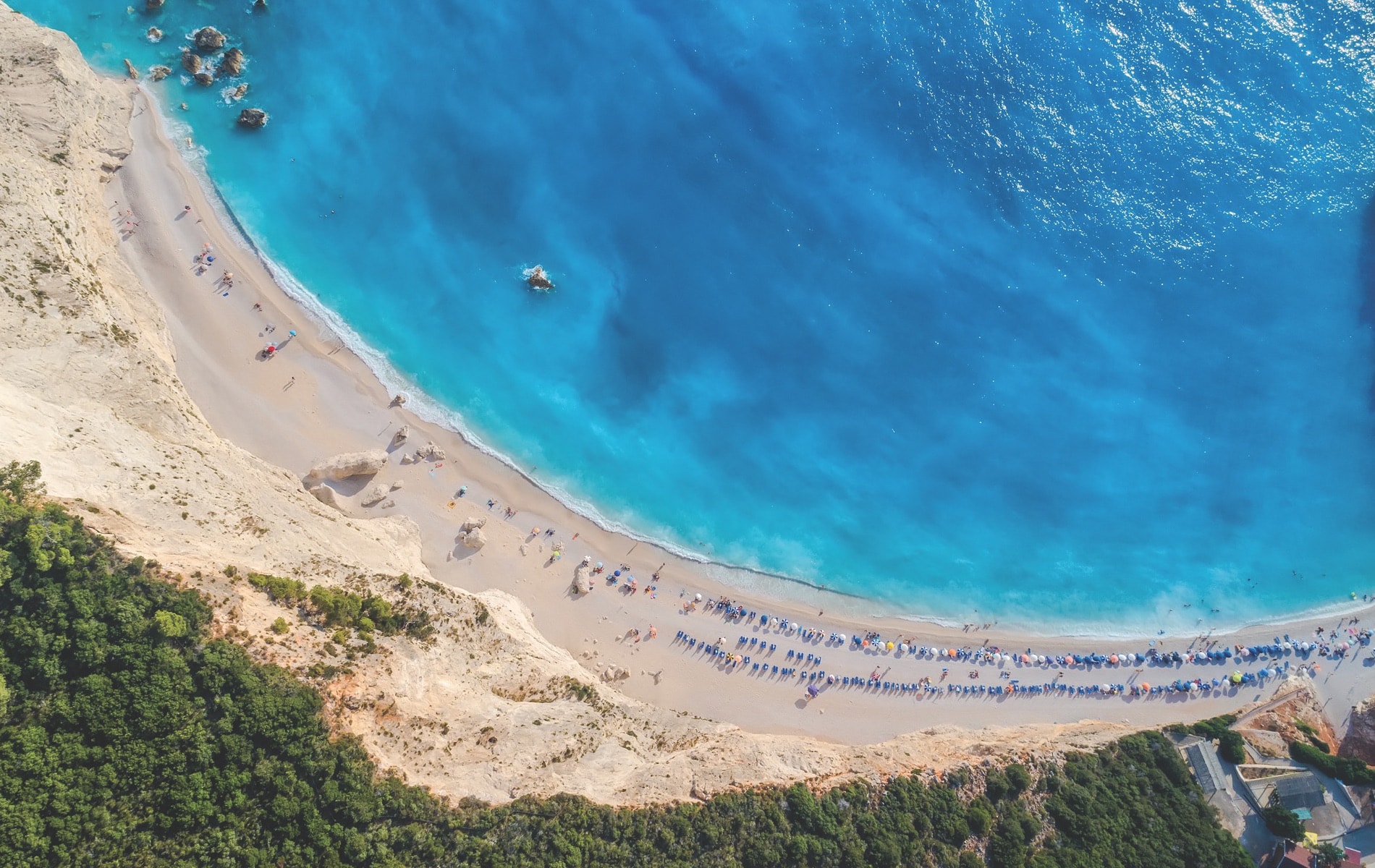
vie-magazine-lefkada-greece-hero-min
An aerial view of the famous beach of Porto Katsiki on the Greek island of Lefkada in the Ionian Sea
Lost in a Myth
Dive into Greek Culture at Lefkada
By Rebecca Hall
Greece is renowned for its history and myths of gods getting up to mischief with mortals. There are even psychological conditions with names that spring from Greek myths (narcissism and Oedipus and Electra complexes come to mind). One thing is for sure: the myths and legends that abound are set in beautiful places across the mainland and islands of this southern European country nestled in the Mediterranean Sea, a gateway between East and West.
Here I look briefly at one Greek character, the poet Sappho, and delve deeper into the beautiful Greek Ionian island of Lefkada, where she reputedly met her tragic death.
Who was Sappho?
Born in approximately 630 BC on the Greek island of Lesbos, Sappho was raised in a society renowned for its literary excellence. Not much is known about her life except that she was the leader of a group who taught young women about art, poetry, and philosophy. During this time on the island, there were several such groups, and they often competed. Sappho was regaled in antiquity as one of the great poets of her time; she was even referred to by some as the “tenth Muse.” Legend has it that because of her unrequited love for Phaon, the ferryman of Lesbos, Sappho threw herself off the Leucadian cliffs (Lefkada was formerly called Leucas) and drowned. It is worth noting here that while she was referred to as a “lesbian,” the term is likely an all-encompassing one to describe individuals hailing from Lesbos. Her sexuality is still a topic of debate among modern scholars, but some believe that she had a daughter, Cleïs.
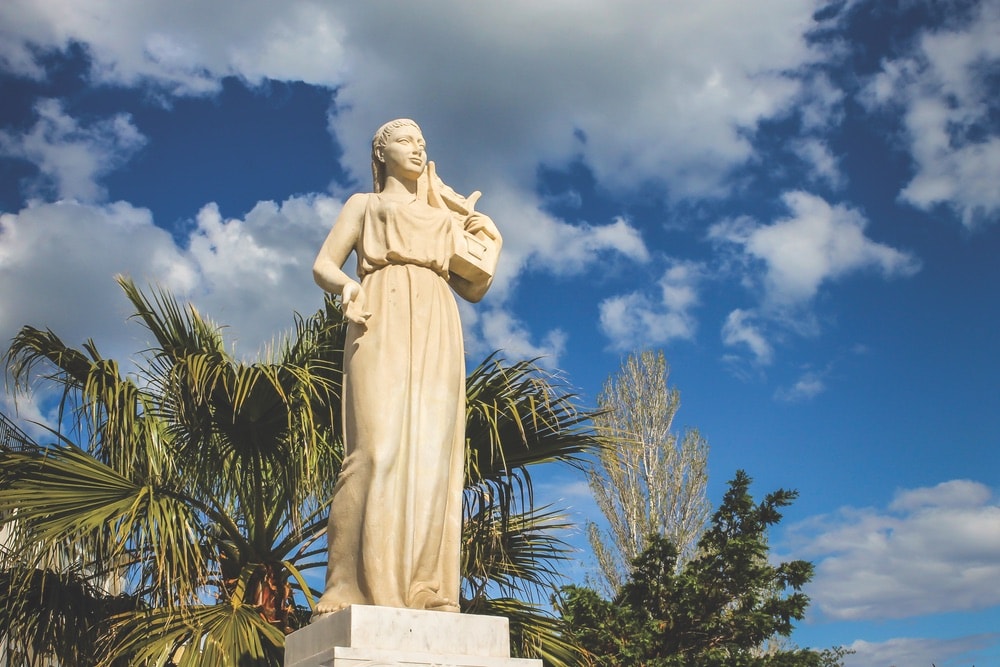
A statue of the ancient lyric poet Sappho can be found in the Sappho Square in the city of Mytilene, Greece.
Lefkada
With over twelve hundred Greek islands to visit (admittedly, some of them are just uninhabited rocks), it’s good to get away from the huge tourist crowds and the islands that have reached saturation point to explore lesser-known ones. Lefkada is one such place.
Located in the Ionian Sea off the west coast of mainland Greece, Lefkada is only 128 square miles, much of which is rough track taking visitors to hidden coves, mountain villages, and monasteries with magnificent views across the sea.
The Ionian Islands are covered in greenery thanks to heavy winter—and sometimes summer—rainfall. The beautiful green landscape gives way to tree-covered cliffs that descend to the blue sea. These white limestone cliffs, trademarks of Lefkada and neighboring islands such as Cephalonia and Zákynthos, create a breathtaking juxtaposition to the turquoise waters along the beaches. The coastal vistas rival those found on any Caribbean or Indian Ocean island.
Although Lefkada is considered an island, it is connected to the mainland by a long causeway that travels through lagoons and a ninety-eight-foot floating pontoon bridge. Despite being a lesser-known destination, tourists are never short of things to occupy their time here.
Beaches
One of the main beaches of the island is Porto Katsiki, which has been named one of the top ten beaches in Greece and the Mediterranean. When you experience the dramatic white cliffs, the sandy beach, and the turquoise waters, it’s easy to see why. It’s accessible by steps from the parking lot on the cliff and by water taxi from the small towns of Vasiliki and Nidri. Many private yachts can be seen anchored off the shores, where there are sun beds, umbrellas, bars, and a canteen.
When you experience the dramatic white cliffs, the sandy beach, and the turquoise waters, it’s easy to see why.
For those who prefer quieter beaches, stop to take photographs at Porto Katsiki and then move on to Agiofili Beach, a little over a mile from the southern harbor town of Vasiliki. You can walk there (but only if you’re hardy—especially in the heat of the summer) or take your car, but the best way to reach the beach is by boat; for about five euros, you can take a water taxi from Vasiliki. Agiofili is reputed to be one of the cleanest beaches on the island.
Mountain villages
When you’ve had enough beach time, a drive into the Stavrota Mountains on the island is well worth it for the views, not to mention the joy of coming across small churches here and there. The mountains peak at 3,878 feet, and as you drive, you’ll be afforded sweeping vistas across the valleys below and out across the Ionian Sea to surrounding islands such as Cephalonia and Ithaca.
One of the most popular mountain villages to visit is Karya, famous for its exquisite embroidery and lace. You’ll notice small shops selling these, as well as a cultural display in the small Folklore Museum. Karya is 1,640 feet above sea level, and it’s a favorite pastime to sit in the village square among the ancient plane trees and sip a frappé or eat lunch in one of the many tavernas. On a hot day, it’s great to wash your hands and cool yourself in the natural springs that flow into the village.
If you’re visiting the island in August, be sure to head to Karya on the eleventh of the month, when a traditional wedding is reenacted using handmade dresses from times past. It’s considerably cooler in the mountains due to their elevation, so be sure to bring a light sweater.
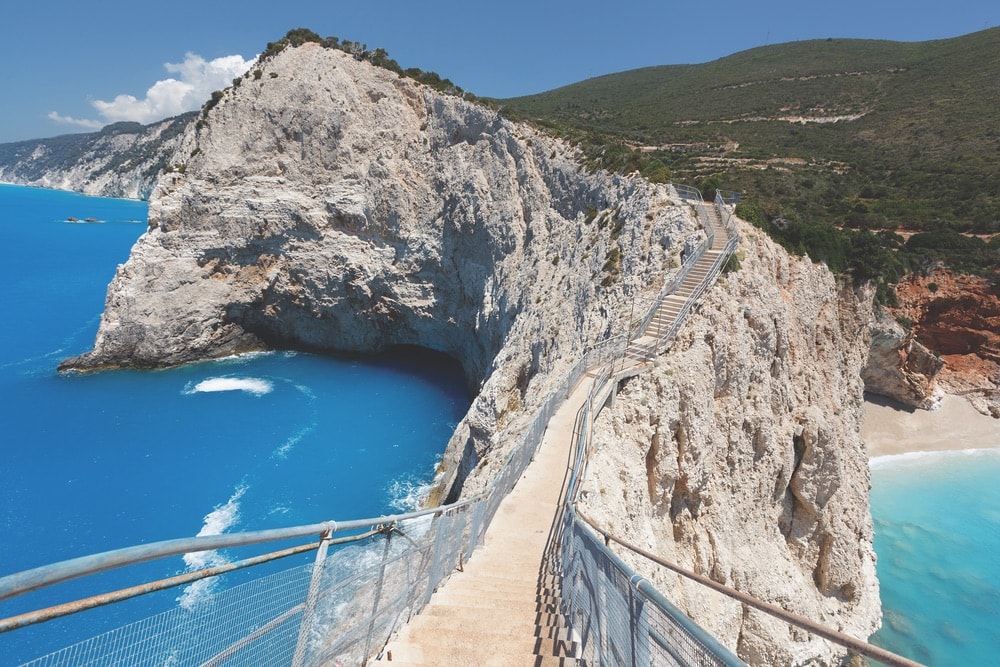
A panoramic view of beautiful Lefkada and the sea as seen from the bridge above Porto Katsiki beach
Monastery of Saint Nicholas
Perhaps one of my favorite things to do in Lefkada is to visit the Monastery of Saint Nicholas. Located near Porto Katsiki, it’s a working monastery that offers stunning views across the plains and out to sea. Three nuns live there: two sisters, who came in 2013, and one of the oldest nuns in Greece, who settled there a year later.
The place was a ruin before they arrived, and they have developed a place that can only be described as tranquil. You don’t have to be religious to enjoy your time here. The younger nuns speak perfectly good English and have delightful senses of humor; they are happy to sit and chat with visitors in the courtyard over homemade lemonade.
Public services are every Sunday morning from seven to ten, but visitors can tour the monastery anytime. There is also a shop that sells goods made by the nuns, such as homemade preserves and honey from their bees.
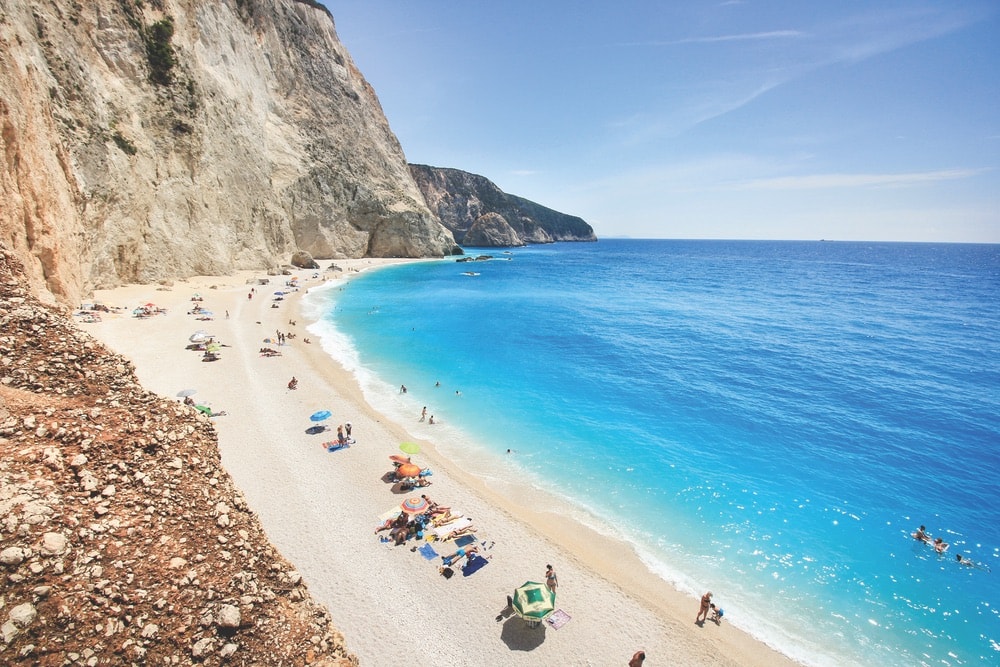
Days spent at the beach in Lefkada are punctuated by hiking, exploring the quaint towns, and visiting the monasteries.
Cape Lefkadas
Coming back to Lefkada’s link to Sappho the poet, the lighthouse at Cape Lefkadas on the southernmost tip of the island stands at a height of ninety-eight feet. It marks the place where Sappho is said to have leaped to her death when her lover rejected her.
Built in 1913, the lighthouse and surrounding area are stunning and offer great views across the Ionian Sea. There’s also great diving to be had here (for professionals), with a depth of 131 feet and excellent visibility thanks to the clear waters. You’ll see plenty of lobsters when diving here, but note that due to strong currents, it’s not recommended for amateurs.
Whether attracted by the island’s mythical history or simply its stunning views and idyllic towns and beaches, there’s no doubt visitors will leave Lefkada with their own stories to tell.
— V —
Head to VisitGreece.gr to start planning your trip!
Rebecca Hall is an English language teacher turned travel writer and novelist. After life in the UK became too cold, she moved to sunny Greece and admits the slightly chaotic nature of it suits her very well. She writes for various online publications such as Weather2Travel, has contributed to guidebooks such as The Rough Guide to Greece, The Rough Guide to the Greek Islands, and The Rough Guide to Portugal, and maintains her travel blog, Life Beyond Borders, encouraging others to travel beyond the borders of geography and their minds. Her debut novel, Girl Gone Greek, was released at the height of the Greek debt crisis in 2015 with the aim to bring a positive view of the country; it has been written into a screenplay in the hope that it will be picked up for production.
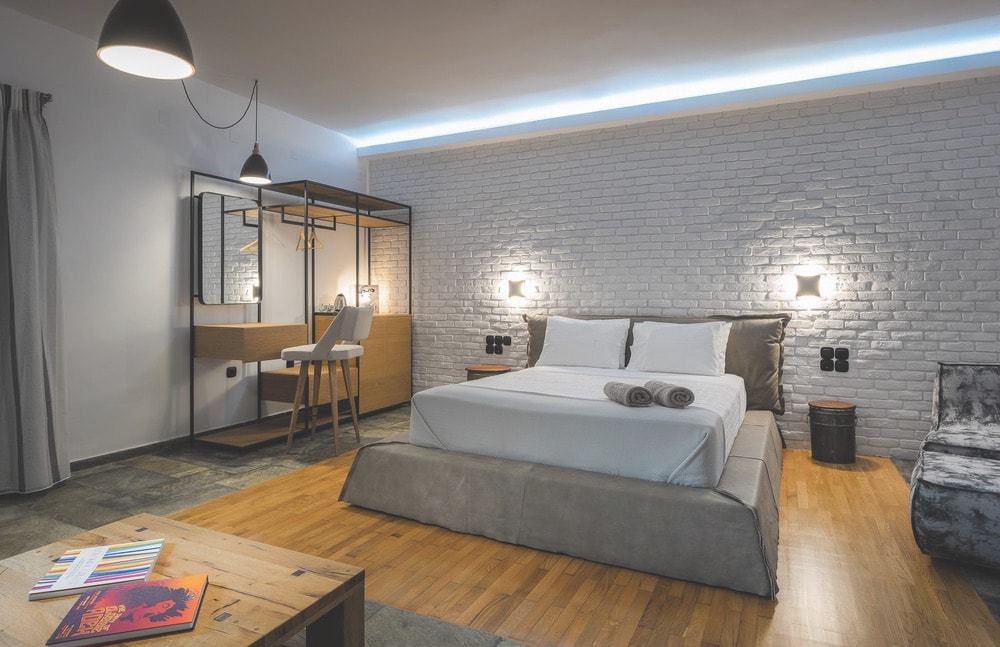
The Rock ’n’ Roll Suite at the Secret Boutique Hotel featuring furnishings by Fabbrica | Photo by Kostas Vassis
If You Go . . .
Fly to Aktion Airport, a small international airport on the mainland, and take a hired car or taxi to the island. Drives will take about forty-five minutes to an hour.
You can also travel to Lefkada by private transfer or taxi from Athens (approximately five hours). This is a great option if you have three or four passengers who can split the cost—roughly $81 each.
Stay in Sappho Boutique Suites in the southern harbor town of Vasiliki. The hotel offers eight boutique suites—four of them have their own private plunge pools—and a seventy-two-foot infinity waterfall pool with glass walls. With free private parking and a ten-minute stroll into Vasiliki to sample the gastronomic delights of the area, you’re well located here to explore the many beaches and Cape Lefkadas. SapphoBoutiqueSuites.com
Located in Lefkada Town, the island’s capital, Secret Boutique Hotel is the perfect choice to be in the middle of shopping, dining, and culture. It is within walking distance of the bustling main square of the town, where there are shops and tavernas aplenty. Secret Boutique offers five suites, each with its own unique style and concept. Also offering free parking, you’re well located here to explore the northern part of the island and even mainland Greece if you wish. SecretBoutiqueHotel.gr
Share This Story!
KEEP UP WITH THE LATEST STORIES FROM VIE
















































































































































